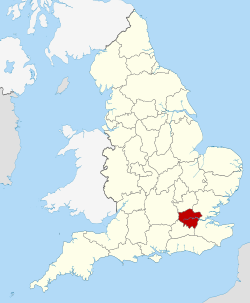Metropolitan Police District | |
|---|---|
 Metropolitan Police District and English police areas (City of London police area not shown) | |
| Status | Police area |
| Established | 1829 |
| Area | |
• Total | 1,578 km2 (609 sq mi) |
| Population | |
• Total | 9,000,000 |
| • Density | 5,700/km2 (15,000/sq mi) |
| Police | Metropolitan Police Service |
The Metropolitan Police District (MPD) is the police area which is policed by the Metropolitan Police Service in London. It currently consists of the ceremonial county of Greater London, which excludes the City of London. The Metropolitan Police District was created by the Metropolitan Police Act 1829 as an ad hoc area of administration because the built-up area of London spread at the time into many parishes and counties without an established boundary. The district expanded as the built up area grew and stretched some distance into rural land. When county police forces were set up in England, those of Essex, Hertfordshire, Kent and Surrey did not cover the parts of the counties within the MPD, while Middlesex did not have a county force. Similarly, boroughs in the MPD that elsewhere would have been entitled to their own police force did not have them.
Contents
- History
- Creation
- 1840 revision
- 1946 revision
- 1965 revision
- 1990s revision
- 2000 revision
- Use for other purposes
- Exceptions
- References
The MPD was originally defined in reference to civil parishes and in 1946 was altered to correspond to local government districts. The MPD has been used for other purposes during its existence, such as the boundary for coal tax and as a 'Greater London' statistical unit. When the Greater London Council was established in 1965, the MPD was expanded to include all of its territory, though some areas that did not become part of Greater London continued to be within it. In 2000, when the Greater London Authority was formed, the outer boundary of the MPD was retracted to coincide with Greater London and the neighbouring county forces then became responsible for those areas outside Greater London. The MPD now consists of the 32 boroughs of Greater London (including the City of Westminster), while the City of London is served by the City of London Police.

